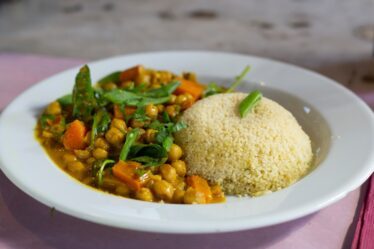
Indian cuisine is renowned for its complex and diverse flavors that tantalize the taste buds. At the heart of Indian cooking lies the use of spices, which play a crucial role in creating the unique and vibrant flavors that are characteristic of this cuisine. The use of spices in Indian cooking dates back to ancient times, with references to their use found in ancient texts and scriptures.
Key Takeaways
- Indian cuisine is a world of flavorful spices that offer a unique and delicious taste.
- Spices are an essential part of Indian cooking, adding aroma and vibrancy to dishes.
- From cumin to turmeric, Indian cuisine uses a wide range of spices that vary by region and dish.
- Regional Indian cuisine offers a diverse range of flavors, from the north to the south, east to west.
- Classic Indian dishes like butter chicken and biryani are popular worldwide for their rich and complex flavors.
The Importance of Spices in Indian Cooking: Aromatic and Vibrant
Spices are not only used to add flavor to Indian dishes but also have medicinal properties and health benefits. They are known for their aromatic qualities, which add depth and complexity to the dishes. Each spice has its own distinct flavor and aroma, and when combined, they create a unique flavor profile in each dish.
In addition to their culinary uses, spices in Indian cuisine also have various health benefits. For example, turmeric is known for its anti-inflammatory properties, while cumin aids digestion and coriander helps in detoxification. The use of spices in Indian cooking is not just about adding flavor but also about promoting overall well-being.
Understanding the Different Spices Used in Indian Cuisine: From Cumin to Turmeric
Cumin, coriander, and turmeric are some of the most commonly used spices in Indian cooking. Cumin adds a warm and earthy flavor to dishes, while coriander adds a fresh and citrusy note. Turmeric, with its vibrant yellow color, is used both for its flavor and as a natural food coloring agent.
Other spices commonly used in Indian cuisine include cardamom, cinnamon, cloves, and mustard seeds. Cardamom adds a sweet and floral aroma to dishes, while cinnamon adds warmth and sweetness. Cloves have a strong and pungent flavor, while mustard seeds add a nutty and slightly bitter taste.
Each spice has its own unique flavor and aroma, and the combination of these spices is what gives Indian cuisine its distinct taste.
Regional Indian Cuisine: From the North to the South, East to West
| Region | Popular Dishes | Ingredients | Spice Level |
|---|---|---|---|
| North India | Butter Chicken, Rogan Josh, Chole Bhature | Tomatoes, Onions, Garlic, Ginger, Garam Masala | Medium to High |
| South India | Dosa, Idli, Sambar, Rasam | Coconut, Tamarind, Curry Leaves, Mustard Seeds | Low to Medium |
| East India | Machher Jhol, Litti Chokha, Rasgulla | Mustard Oil, Panch Phoron, Poppy Seeds | Medium |
| West India | Vada Pav, Pav Bhaji, Dhokla | Garlic, Ginger, Green Chillies, Cumin Seeds | Medium to High |
India is a vast country with a diverse range of regional cuisines. Each region has its own unique flavors and cooking techniques, influenced by factors such as climate, geography, and cultural traditions.
North Indian cuisine is known for its rich and creamy dishes, often made with ingredients like ghee (clarified butter), cream, and yogurt. Popular dishes from this region include butter chicken, biryani, and naan bread.
South Indian cuisine, on the other hand, is characterized by its use of coconut and rice. Dishes from this region often feature coconut milk, curry leaves, and mustard seeds. Some popular South Indian dishes include dosa (a fermented rice and lentil crepe), idli (steamed rice cakes), and sambar (a lentil-based vegetable stew).
Eastern Indian cuisine is known for its use of mustard oil and fish. Bengali cuisine, in particular, is famous for its seafood dishes and sweets like rasgulla (cheese balls soaked in sugar syrup).
Western Indian cuisine is known for its spicy and flavorful dishes. The state of Gujarat is famous for its vegetarian cuisine, which includes dishes like dhokla (steamed fermented rice cakes) and thepla (spiced flatbread).
Classic Indian Dishes: From Butter Chicken to Biryani
Indian cuisine is home to a wide variety of classic dishes that are loved by people all over the world. Butter chicken is one such dish that has gained immense popularity. It is a rich and creamy tomato-based curry made with marinated chicken cooked in a tandoor (clay oven). The dish is typically served with naan bread or rice.
Biryani is another classic Indian dish that is loved for its flavorful rice and tender meat or vegetables. It is a one-pot dish made by layering rice and meat or vegetables, along with a blend of spices, and cooking it on low heat until the flavors meld together.
Other classic Indian dishes include tikka masala, which is made with marinated and grilled chicken in a creamy tomato-based sauce, and samosas, which are deep-fried pastries filled with a savory filling of potatoes, peas, and spices.
Vegetarian Indian Cuisine: A Delicious and Healthy Alternative

Indian cuisine offers a wide range of vegetarian options that are both delicious and healthy. Lentils, chickpeas, and paneer (Indian cottage cheese) are commonly used in vegetarian dishes to provide protein and flavor.
Dal is a staple in Indian vegetarian cuisine. It is a lentil-based dish that can be made in various ways, such as dal tadka (tempered lentils) or dal makhani (creamy black lentils). Chickpeas are another popular ingredient in vegetarian dishes, with chana masala being a favorite among many.
Paneer is a versatile ingredient that is often used in vegetarian curries and snacks. It has a mild and creamy flavor that pairs well with spices and other ingredients. Some popular paneer dishes include palak paneer (paneer cooked in a spinach gravy) and paneer tikka (grilled paneer skewers).
Vegetarian Indian cuisine is not only delicious but also provides a wide range of nutrients from different ingredients. It is a healthy and flavorful alternative to meat-based dishes.
Street Food in India: Exploring the Colorful and Flavorful Options
Street food is an integral part of Indian culinary culture. It is not only delicious but also affordable, making it a popular choice among locals and tourists alike. Street food in India is known for its bold and spicy flavors that are sure to tantalize your taste buds.
Chaat is one of the most popular street foods in India. It is a savory snack made with a combination of crispy fried dough, potatoes, chickpeas, yogurt, and various chutneys. The flavors are a perfect balance of sweet, sour, and spicy.
Vada pav is another popular street food that originated in the state of Maharashtra. It consists of a deep-fried potato fritter served in a bun with chutneys and spices. It is often referred to as the Indian version of a burger.
Dosa is a South Indian street food that has gained popularity all over the country. It is a thin and crispy rice and lentil crepe that is typically served with coconut chutney and sambar. It can be filled with various fillings like potato masala or paneer.
Indian Desserts: Sweet Treats with a Touch of Spice
Indian desserts are known for their use of spices and flavors that create a unique and indulgent experience. They are often made with ingredients like milk, sugar, ghee, and nuts.
Gulab jamun is one of the most popular Indian desserts. It is made by deep-frying milk solids dumplings and then soaking them in a sugar syrup flavored with cardamom and rose water. The dumplings are soft and melt in your mouth, while the syrup adds sweetness and aroma.
Rasgulla is another beloved Indian sweet treat. It is made by boiling balls of cottage cheese in a sugar syrup until they become spongy and absorb the sweetness of the syrup. Rasgulla is often served chilled and is a refreshing dessert option.
Kulfi is a traditional Indian ice cream that is made by simmering milk until it reduces to a thick consistency and then freezing it in molds. It comes in various flavors like mango, pistachio, and saffron. Kulfi is often garnished with nuts and served on a stick.
Pairing Indian Cuisine with Wine and Beer: The Perfect Complement
Indian cuisine can be paired with both wine and beer to enhance the dining experience. The key is to choose beverages that complement the flavors and spices of the dishes.
Light beers and white wines are a good choice for pairing with spicy Indian dishes. The carbonation in beer helps to cleanse the palate, while the acidity in white wines helps to balance the heat. Sauvignon Blanc and Riesling are popular choices for pairing with Indian cuisine.
Red wines and dark beers pair well with rich and creamy Indian dishes. The tannins in red wine help to cut through the richness of the dishes, while the maltiness of dark beers complements the flavors. Cabernet Sauvignon and stout beers are good options for pairing with Indian cuisine.
Cooking Indian Cuisine at Home: Tips and Tricks for a Flavorful Meal
Cooking Indian cuisine at home can be a rewarding experience, allowing you to experiment with different flavors and spices. Here are some tips and tricks to help you create a flavorful Indian meal:
1. Start with the basics: Cumin, coriander, and turmeric are the foundation of many Indian dishes. Invest in good quality whole spices and grind them fresh for the best flavor.
2. Use fresh ingredients: Fresh ingredients like ginger, garlic, and onions add depth and flavor to Indian dishes. Avoid using pre-packaged spice mixes or pastes as they may not have the same freshness or flavor.
3. Experiment with spice combinations: Don’t be afraid to experiment with different spice combinations to create your own unique dishes. Indian cuisine is all about bold flavors, so don’t be afraid to add a little extra spice or heat if you prefer.
4. Take your time: Many Indian dishes require slow cooking or marinating to develop their flavors fully. Take your time and allow the flavors to meld together for the best results.
5. Balance the flavors: Indian cuisine is all about balancing flavors like sweet, sour, salty, and spicy. Taste your dishes as you cook and adjust the seasonings accordingly.
Cooking Indian cuisine at home can be a fun and flavorful experience. With a little practice and experimentation, you can create delicious and authentic Indian dishes right in your own kitchen. So go ahead, explore the world of Indian spices and flavors, and embark on a culinary journey like no other.
If you’re a fan of Indian cuisine and love experimenting with different spices, then you’ll definitely want to check out this article on Flavorful Sips. They have a fantastic guide on how to use Indian cooking spice to enhance the flavors of your dishes. From aromatic cumin to fiery chili powder, this article covers it all. Discover the secrets of Indian cooking and take your culinary skills to the next level. Don’t miss out on this incredible resource! Click here to read more.



